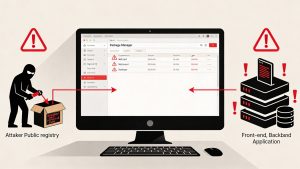Version strings look simple, yet they sit on a critical path. A single mismatch can force an emergency rollback, stall a pipeline, or leave a cluster in an unknown state. Semantic versioning solves that problem through a contract that every tool and engineer can evaluate without context. When an artifact moves from 1.8.5 to 1.9.0, continuous delivery platforms, dependency managers, and production engineers all know what that means—no side meetings, no guesswork. This article unpacks semver from first principles, explains each rule in production language, highlights edge-case pitfalls, and maps the practice to real systems such as container images, Terraform modules, and Helm charts. Treat it as a reference that answers the “when,” “why,” and “how” every time you cut a release or consume one produced by another team.
What is Semantic Versioning?
Semantic versioning is a specification that maps meaning to every segment of a version string. The spec dictates three immutable truths:
- The public interface must be declared.
- Every change lands under a new tag; tags are never edited.
- The tag communicates risk: breaking, additive, or corrective.
A project that follows semver gives downstream consumers a deterministic way to decide if an upgrade is safe. For DevOps engineers this translates to automation. A build server can approve a patch bump without human review; a deployment controller can gate a major bump behind a canary phase; a configuration-as-code repo can express version ranges that remain valid for years.
Semver works only when the public API is explicit. In a library the API is source signatures, in a microservice it is an HTTP contract, and in a CLI it is flags and exit codes. Once declared, any change to that surface determines the segment you bump.
The model applies equally to internal services. An SRE maintaining a fleet of sidecars can check the version string in a new container image and decide if an orchestration job can replace pods in place or must coordinate a rolling drain. That decision happens in code, not in a chat channel.
The Semantic Versioning Format
A valid tag follows this grammar:
php-template
<major>.<minor>.<patch>[-<pre-release>][+<build>]Core numbers
- MAJOR – non-negative integer that changes only when the interface breaks.
- MINOR – non-negative integer that changes only when new, compatible behavior appears or when something is deprecated.
- PATCH – non-negative integer that changes only when defects are corrected without interface changes.
Each field increments numerically; no leading zeros are allowed. The hierarchy is strict—major outranks minor, minor outranks patch.
Optional identifiers
A hyphen introduces a pre-release label. It signals instability. Typical forms include alpha, beta, rc.1, or arbitrary dotted chains like 0.3.7. Pre-release versions sort lower than the normal version with the same core numbers.
A plus sign introduces build metadata. It stores build date, commit hash, or packaging notes. Examples: +git.9c2af, +20250604, +linux.amd64. Build metadata never affects ordering, so 1.4.2+sha equals 1.4.2+date.
Precedence rules in practice
- 1.4.0 > 1.3.9 – major wins.
- 2.2.1 > 2.1.9 – minor wins if major equal.
- 3.2.5 > 3.2.4 – patch wins if major and minor equal.
- 1.0.0 > 1.0.0-rc.3 – normal outranks pre-release.
- 1.0.0-alpha.3 > 1.0.0-alpha.2 – alphabetical or numeric compare per identifier.
- 1.0.0+build2 == 1.0.0+build9 – build metadata ignored.
These rules let package managers resolve constraints deterministically. Yarn’s ^1.2.0, Maven’s [1.5.0,2.0.0), Go’s go get with @1.17—all build their logic on these comparisons.
Development space
A leading major zero (0.y.z) reserves a sandbox where anything can break. Use it for prototypes or unstable internal tools. Once production systems depend on the artifact, move to 1.0.0 and honor the rules.
When to Increment: Rules of SemVer
A quick bumper sticker summary—patch fixes, minor adds, major breaks—covers 80 percent of cases. DevOps pipelines hit the other 20 percent daily, so here is a more granular checklist.
Patch version (x.y.Z)
- Fixes a fault detectable by users.
- Does not add, remove, or rename any interface element.
- May change internal algorithms, memory use, or performance as long as outputs remain consistent.
- Safe for hot patch in production if CI passes.
Minor version (x.Y.0)
- Introduces new public functionality without breaking existing calls.
- Adds deprecated tags or fields but keeps them operational.
- May bundle internal patch fixes; patch resets to zero.
- Suitable for scheduled rollout with standard regression tests.
Major version (X.0.0)
- Removes or changes any public element.
- Alters default behavior, exit codes, or message structures.
- Requires consumer code change or migration steps.
- Demands a migration plan and usually a staged rollout with canaries and feature flags.
Pre-release identifiers
Use pre-release labels to publish early builds for testing:
- -alpha – unstable, feature may change shape.
- -beta – feature stable, defects likely.
- -rc – release candidate, only critical defects will block promotion.
Pipelines often deploy alpha builds to ephemeral environments, beta builds to internal staging, and only promote rc to production after sign-off.
Build metadata
Packagers embed data useful for traceability:
- Git commit (+g9c2afee).
- Build timestamp (+20250604.1200).
- Target platform (+linux.amd64).
Because metadata does not alter ordering, downstream tools can compare 1.4.2+linux with 1.4.2+darwin as equal precedence but still know which binary to pull.
Dependency chains
If your library upgrades a dependency from 1.9.7 to 2.0.0, treat that as a breaking change if and only if your public behavior changes. If the interface stays the same, you can bump minor or patch. Document the new dependency version in release notes either way so that operators can update lockfiles accordingly.
Commit-message driven bumps
Tools such as semantic release mine commit history:
- fix: – bump patch.
- feat: – bump minor.
- BREAKING CHANGE: – bump major.
The script updates package.json, tags the commit, creates a GitHub release, and pushes to the registry. Engineers write the message once; the automation enforces the contract every time.
Benefits of Using Semantic Versioning
- Automated safety – CI/CD gates parse version deltas. A minor bump can auto-deploy; a major bump waits for manual approval.
- Stable dependency graphs – Package managers calculate non-breaking upgrade paths. A Node.js service that pins ^4.1.3 accepts any 4.x.y patch or minor but rejects 5.0.0.
- Predictable maintenance windows – Ops leads schedule major upgrades with runbooks while allowing minor and patch updates during normal hours.
- Faster incident response – Tags embed commit hashes, letting on-call staff bisect regressions quickly and roll back safely.
- Clear communication – Business stakeholders see a major bump and anticipate migration work; a patch bump signals routine maintenance.
- Reproducible builds – Immutable tags mean that rebuilding version 2.3.1 tomorrow produces the same bits, critical for supply-chain security reviews.
These gains compound across an organization. When every repo—microservice, infrastructure module, CLI tool—uses the same signals, platform teams can write one policy engine that governs all of them.
Common Mistakes and How to Avoid Them
- Tag reuse
- Re-tagging a hash breaks Docker layer caching and violates artifact immutability policies. Tag once and forget.
- Hidden breaking change
- Refactoring a data schema without bumping major forces consumers to adapt under a minor tag. Add a migration script, bump major, and document.
- Over-bumping
- Jumping major for a typo fix inflates perceived risk. Confirm interface impact before deciding the segment.
- Ambiguous API
- If a gRPC service lacks explicit proto versioning, any protobuf change is arguable. Lock the proto file under version control, update version comments in the file, and reference it in the changelog.
- Using build metadata to signal stability
- A string like 1.4.2+unstable reads as stable to ordering logic. Put instability in a pre-release label (-alpha).
- Neglecting documentation
- Semver communicates risk but not content. Release notes must still describe what changed and why.
- Ignoring transitive risk
- Updating an HTTP client that now enforces TLS 1.3 is a breaking change for downstream services that run on older stacks. Bump major.
- Inconsistent tooling across languages
- Publishing a Rust crate with cargo’s caret defaults while publishing a Python wheel with loose ranges causes drift. Standardize policy and enforce with CI lint jobs.
- Skipping deprecation window
- Removing an endpoint in 2.0.0 without marking it deprecated in 1.x leaves users stranded. Deprecate in a minor first, remove in the next major.
- Assuming 0.y.z grants immunity
- Some teams treat 0.99.0 as production ready. Consumers cannot rely on stability there. Move to 1.0.0 once the API holds value.
A simple guardrail is a pull request template:
shell
### Does this change break the public API?### If yes, document the removal or alteration and bump major.### If no, does it add new public behavior?### If yes, bump minor. Otherwise bump patch.CI can parse that template to ensure the tag aligns with the answer.
Real-World Examples of Semantic Versioning
Kubernetes
The project releases a new minor every three months (1.30.0, 1.31.0). Patch updates address CVEs and regressions. Cloud providers gate automated upgrades to the next minor only after extensive soak tests. Major bumps appear rarely; the leap from 1.x to 2.0.0 would signal drastic API surgery such as removal of deprecated objects.
Node.js
Odd majors are short-term, even majors receive long-term support. An enterprise can run 18.x for three years, knowing that 18.22.1 will never break application binaries while still receiving security backports.
Terraform Providers
HashiCorp sets expectations: a module can declare >=5.0.0, <6.0.0 for the AWS provider and trust that every 5.y.z upgrade retains argument compatibility. When the provider jumps to 6.0.0, module authors plan a migration but can ignore patch churn.
React
Legacy rendering paths remained intact through many minors. The jump to concurrent rendering shipped under 18.0.0. Projects pinned to ^17.0.0 were unaffected until ready to migrate.
Helm Charts
Charts use two semver lines: appVersion for the container image, version for the chart template. Operators can bump the chart without touching the workload image or vice versa, each change clearly signaled.
Debian Packages
Debian’s apt respects semver when upstream tarballs adopt it. A back-ported patch release like 1.14.7-2+deb11u3 tells maintainers the ABI is constant, letting them push security fixes without triggering re-compiles of reverse dependencies.
Container Images in Production-Grade Registries
Registries store both moving tags like latest and immutably versioned tags like 3.2.1. Production controllers pin to the latter to avoid unexpected major upgrades during auto-scaling events.
These cases demonstrate semver crossing language, tool, and domain boundaries—one spec, many ecosystems.
Conclusion
A release number is a tiny string that drives giant decisions. Semantic versioning turns that string into a reliable, machine-readable contract. Follow the format, bump the right segment, keep tags immutable, and publish notes that match the bump. Automate the process with semantic release or similar tools so the rule set never drifts. When every artifact in your stack speaks semver versioning, continuous delivery moves from risky ceremony to routine engineering.



